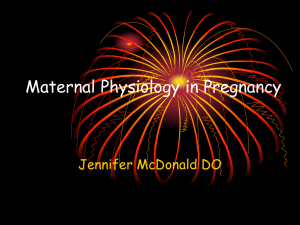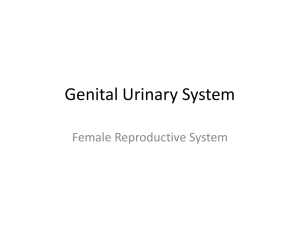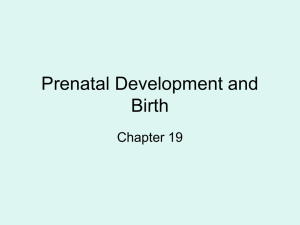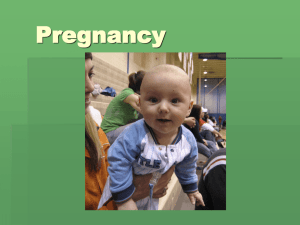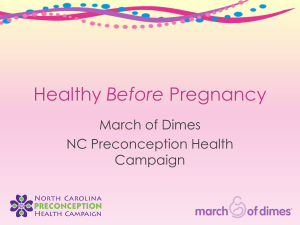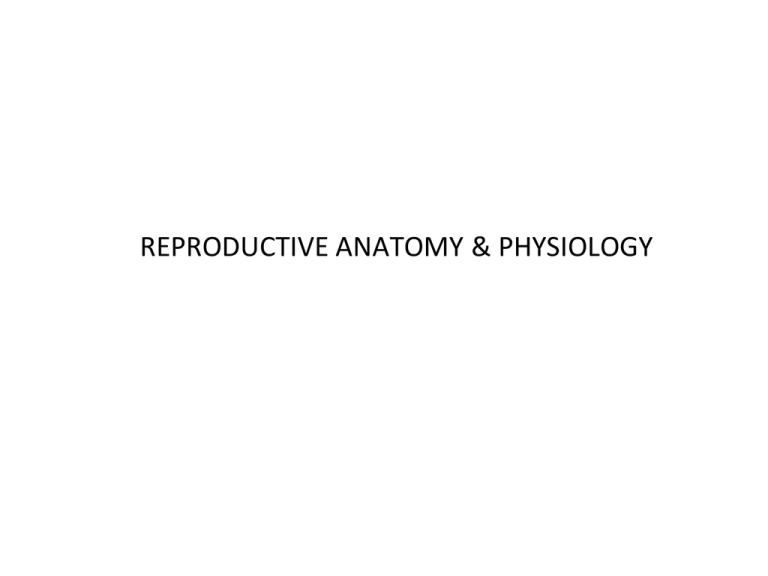
REPRODUCTIVE ANATOMY & PHYSIOLOGY
EARLY DEVELOPMENT
• Male & Female organs
– produce sex cells
– transport for union
• Sex Differentiation at 8 weeks of life
– Ovary - produces oogonia at 10 weeks of fetal
life; approximately 150,000 oocytes present at
birth
– Testes - produces spermatoza at 7-8 weeks
Reproductive Anatomy
• External Organs
–
–
–
–
–
Mons Pubis
Labia Majora
Labia Minora
Clitoris
Vaginal Vestibule
•
•
•
•
•
Urethral meatus
Skene’s Glands
Hymen
Fourchete
Perineum
Figure 2–1 Female external genitals, longitudinal view.
Reproductive Anatomy con.
• Internal Organs
– Vagina
– Uterus
• Fundus
• Corpus
• Isthmus
• Cervix
Figure 2–2 Female internal reproductive organs.
Layers of the Uterus
• Perimetrium
– outer layer composed of peritoneum
• Myometrium
– inner layer primarily in the fundus; longitudinal fibers;
causes cervical effacement and power to express the baby
• Endometrium
– innermost layer, produces endometrial milk, undergoes
monthly regeneration
Figure 2–4 Structures of the uterus.
Myometrium
• Muscular Layer - composed of 3 distinct layers
– Longitudinal fibers found mainly over the fundus;
most involved with birth of fetus
– Fibers interlaced with blood vessels in Figure 8
pattern; living ligature – helps stop bleeding
– Circular fibers concentrated around fallopian
tubes and cervical os; helps keep cervix closed
Figure 2–5a Uterine muscle layers. Muscle fiber placement.
Internal Organs con.
• Isthmus
– Joins corpus to the cervix
– Site for lower C/S
• Cervix
– Composed of fibrous connective tissue
– Length 2.5 to 3 cm (~1-2”)
– Functions
• Passage of menses and sperm
• Produces mucus in response to cyclic hormones
• Frequent site for uterine cancer
Bottom of Cervix, Cells are
taken from here for Pap Smear
Uterine Ligaments
Think which ligaments cause pain during pregnancy
• Broad ligament – stabilizes uterus, covers uterus
anteriorly and posteriorly
• Round ligament – helps keep uterus in place from the
sides, pain on sides late in pregnancy
• Ovarian ligament – anchors lower part of ovary, helps
catch ovum in fimbriae
• Cardinal ligament – chief uterine support, prevents
uterine collapse
• Uterosacral ligament – support for uterus at level of the
ischial spine, source of menstrual pain
Figure 2–5b Interlacing of uterine muscle layers.
Figure 2–6 Uterine ligaments.
Fallopian Tubes
• Functions – provide passageway for ovum
into uterus, site for fertilization
• Fimbriae – most distal part, wavelike motion
that pulls ovum into tube
• Ampulla – site for fertilization
• Isthmus - close to uterus, site for BTL
Figure 2–7 Fallopian tubes and ovaries.
Ovaries
• At birth, all ova are contained within
immature follicles
• Functions
1) Ovulation
2) Produce hormones
Bony Pelvis
• Functions – to support and protect the internal
organs of reproduction
• Innominate Bones
– Ilium – upper prominence of hip
– Ischium – under the ilium, ends in ischial tuberosity,
serves as reference point for station
– Pubis – (2 separate bones) front of innominate, meets
other to form symphysis pubis
• Sacrum – 5 fused vertebrae, sacral promontory
• Coccyx – (Tail bone) triangular bone last on
vertebral column, moves backward in childbirth
(Sometimes can get fx’d during childbirth)
Figure 2–8 Pelvic bones with supporting ligaments.
Pelvic Floor (Muscles)
• Designed to overcome force of gravity
• Provides stability and support for surrounding
structures (Help body remain intact, until baby is ready for
birth)
• Pelvic diaphragm – deep fascia, levator ani,
and coccygeal muscles
• Muscles function as a whole, yet are able to
move over one another – provides capacity
for dilatation
Figure 2–9 Muscles of the pelvic floor. (The puborectalis, pubovaginalis, and coccygeal muscles cannot be seen from this view.)
Pelvic Division
• False Pelvis – portion above pelvic brim or
inlet; serves to support pregnant uterus; helps
direct presenting part into true pelvis
• True Pelvis – portion below linea terminalis;
represents the bony limits of the birth canal
• Pelvic inlet – upper border of true pelvis
• Pelvic outlet – lower border of true pelvis
Figure 2–10a Female pelvis. False pelvis is shallow cavity above the inlet; true pelvis is deeper portion of cavity below the inlet.
Figure 2–10b True pelvis consists of inlet, cavity (midpelvis), and outlet.
Figure 8–5a Manual measurement of inlet and outlet. Estimation of the diagonal conjugate, which extends from the lower border of
the symphysis pubis to the sacral promontory.
Figure 8–5b Estimation of the anteroposterior diameter of the outlet, which extends from the lower border of the symphysis pubis to
the tip of the sacrum.
Pelvic Measurements
Helps figure whether baby’s head can fit.
• Diagonal conjugate – extends from the subpubic angle to the
middle of the sacral promontory; can be measured manually (with
hand) during a pelvic exam
– Take and substract 1.5cm to get Obstetric conjugate.
• Obstetric conjugate – extends from the middle of the sacral
promontory to 1 cm below the pubic crest (Cannot be
reached/measured manually)
• Conjugate vera – extends from the middle of the sacral
promontory to the pubic crest
Figure 2–11 Pelvic planes: coronal section and diameters of the bony pelvis.
C
D
Figure 8–5 c & d Methods that may be used to check the manual estimation of anteroposterior measurements.
Figure 8–6 Use of a closed fist to measure the outlet. Most examiners know the distance between their first and last proximal
knuckles. If they do not, they can use a measuring device.
Pelvic Types
•
•
•
•
Gynecoid – most common female, adequate
Android – most common male, not adequate
Anthropoid – usually adequate
Platypelloid – usually not adequate
Figure 15–1 Comparison of Caldwell-Moloy pelvic types.
Female Sex Hormones
• Estrogen
–
–
–
–
–
–
–
–
–
Maturation of secondary sex characteristics
Secreted by the maturation of ovarian follicles
Cause proliferation of endometrial mucosa
Causes increase in size and weight; closure of long
bones
Increases myometrial and fallopian tube contractility
Increases uterine sensitivity to oxytocin
Maintains bone density
Inhibits FSH production and stimulates LH production
May increase libido
Female Sex Hormones con.
• Progesterone “keeps everything quiet”; maintains
pregnancy
– LH stimulates corpus luteum to secrete progesterone
– Decreases motility and contractility of uterus
– Proliferates vaginal epithelium
– Causes cervix to secrete thick viscous mucus
• Anti-sperm
– Prepares breast tissue for lactation
– Thermogenic “heat producing”
• check temp to determine ovulation
– “Hormone of Pregnancy”
Female Sex Hormones con.
• Prostaglandins
– Produces by the endometrium “lining of the uterus”
– Differentiated by Roman letters and numbers or Greek
numbers
– Essential for ovulation (help egg be expelled from the
ovary)
– Causes expulsion of the ovum
– Produces progesterone withdrawal
– Facilitates tissue digestion to cause endometrial
shedding
Neurohormonal Basis of the
Female Reproductive Cycle
Causes menses cycle to occur
• Controlled by an interaction between the
nervous and endocrine systems and their
target tissues – hypothalamus, anterior
pituitary, and ovaries
NEUROHORMONAL BASIS OF THE
FRC
• CNS --- HYPOTHALMUS RELEASES ----GnRF
(FSHRH & LHRH) ------CAUSES
ANTERIOR PITUITARY TO RELEASE FSH & LH --- STIMULATES GONADS TO SECRETE
HORMONES (ESTROGEN & PROGESTERONE)
• In males, LH induces secretion of testosterone.
• In females, LH working w/ FSH stimulate follicle growth in
ovary to secrete estrogen.
Ovarian Cycle
Be able to know which cycle the woman is in
• 1st Part- Follicular Phase (Follicles- where the immature
eggs are contained)
– Starts with day 1 menses; 1-14 days; may vary
– multiple follicles are maturing; one is selected; when mature,
called a graafian follicle; surrounded by fluid …and becomes a
cyst on the ovary.
– Comes close to surface of ovary, forms a blister, ovum pushed
out of the follicle near the fimbria (ovulation)
– Pain at mid-cycle Mittelschmerz (may see blood spotting)
– Pulled into fallopian tube and travels to ampulla where
fertilization can occur
Ovarian Cycle con.
• 2nd Part- Luteal Phase
–
–
–
–
Begins with ovulation (the second half of ovarian cycle)
Corpus luteum develops from the ruptured follicle
If fertilized, the ovum implants into endometrium
Ovum secretes HCG to maintain corpus luteum; the corpus
luteum secretes progesterone and estrogen (cause you have
to have high levels of H to maintain preg)
– If no fertilization, degenerates in about a week and becomes
the corpus albicans
– Estrogen and Progesterone decrease which stimulates FSH
and LH to be released which will start whole cycle over again.
– 14 days after ovulation, menses begins (this remains
constant) A person can then predict ovulation.
Figure 2–14 Various stages of development of the ovarian follicles.
Endometrial Cycle- 4 Phases
• 1) Menstruation
– Cyclic uterine bleeding in response to hormones changes;
begins 14 days after ovulation
– Partial shedding of the endometrium
– Discharge made up of blood, fluid, cervical and vaginal
secretions, bacteria, leukocytes and cellular debris; dark
red, distinctive odor
– Menarche- onset of menstruation; age 9-16
– Cycle lengths vary 21- 36 days; illness, fatigue, stress,
anxiety, vigorous exercise can alter cycle
Endometrial Cycle con.
• 2) Proliferative
– Endometrium increases 6-8 fold, estrogen incr/peaks, cervical
mucus becomes thin (to allow sperm to pass), BBT drops at
ovulation then increases (Progesterone levels incr)
• 3) Secretory
– Estrogen decreases, progesterone dominates, vascularity of
uterus increases, glands begin to secrete endometrial milk for
fertilized ovum
• 4) Ischemic
– If no fertilization, corpus luteum begins to degenerate; estrogen
and progesterone levels fall; leads to tissue necrosis and small
blood vessels rupture, arteries constrict decreasing blood supply
to endometrium; tissue pale, menses begins
Figure 2–13 Female reproductive cycle:
interrelationships of hormones with the four
phases of the uterine cycle and the two
phases of the ovarian cycle in an ideal 28day cycle.
Physical and Psychological
Changes of Pregnancy
Three Pregnancy Periods
Antepartum- from conception to the onset of
labor
Intrapartum- from the onset of labor to the first
1-4 hours after delivery of newborn and
placenta
Postpartum- refers to the 6 weeks after
delivery of the newborn and placenta.
Pregnancy
• Nine months of pregnancy are divided into
three trimesters, each are three months long.
• All systems of a woman’s body are altered in
some way during pregnancy.
Changes of the Reproductive System
• Uterus - increases in capacity and size;
requires one-sixth of maternal blood flow.
• Braxton Hicks - irregular contractions, usually
painless, felt throughout pregnancy, can be
confused with true labor later in pregnancy
• Ovaries – stop ovulation; corpus luteum
continues to produce hormones until 6-8
weeks
Change in the Reproductive System
• Cervix - secretes mucus that forms a plug
– Goodell’s sign - softening of the cervix
– Chadwick’s sign - bluish color of the cervix during pregnancy
• Vagina - mucosa thickens and connective tissue
relaxes; pH acidic favors yeast
Changes in the Reproductive System
cont
• Breasts - increase in size and number of
glands
• Colostrum - thin yellow secretion high in
protein and immune properties
Changes in the Cardiovascular System
• Cardiac output - increases 30-40%
• Pulse – increases 10-15 bpm
• BP - decreases in the 1st and 2nd trimesters;
3rd trimester increases to pre-pregnant levels
• Vena cava syndrome – (Caution!) uterus
compresses the vena cava
S/S: pallor, dizziness and clammy skin
Figure 7–1 Vena caval syndrome. The gravid uterus compresses the vena cava when the woman is supine. This reduces the blood
flow returning to the heart and may cause maternal hypotension.
Caution for Vena cava syndrome!!! Keep head elevated or
turn to one side.
Cardiovascular System cont
• Blood (More volume, but blood is diluted)
– volume increases 45%
– RBCs increase 18 to 30%
– Plasma volume increases 50%
• Physiologic anemia – more diluted
Changes in the Respiratory System
•
•
•
•
Growing uterus elevates the diaphragm
Increased 02 needs
Increased air volume exchange
Nasal stuffiness and epistaxis from increased
estrogen
Changes of the Musculoskeletal
System
• Teeth/gums – bleeding gums; oral hygiene
important to prevent preterm labor
• Relaxation of the pelvic joints – “Waddling” gait
• Physiologic lordosis - lumbar spinal curvature
increases compensating for weight of uterus
• Diastasis recti - separation of the rectus abdominal
muscle
Figure 7–3 Postural changes during pregnancy. Note the increasing lordosis of the lumbosacral spine and the increasing curvature of
the thoracic area.
Changes of the Gastrointestinal
System
• 1st trimester – Incr HCG causes N/V
• Increased progesterone levels – causes
decreased peristalsis reflux and
constipation (Fiber and fluids important)
• Hemorrhoids - constipation and increased
pressure on blood vessels in the rectum
Changes of the Renal System
• Urinary frequency
• Glomerular filtration - increases 50%
• Glycosuria – more prone to develop gestational
diabetes.
Changes in the Integumentary System
• Increased pigmentation - areola, nipples and vulva
• Chloasma - mask of pregnancy
• Linea nigra - darkly pigmented line from umbilicus to
the pubic area
• Striae gravidarum - stretch marks
• Sweat and sebaceous gland activity increases
Changes in the Endocrine System
• Metabolism - increases
• Weight gain – Norm 3 to 5 pounds 1st
trimester; 1 pound/week 2nd and 3rd
trimesters. (Avg 25-35lb incr throughout preg)
• Water retention - increased sex hormones
and decreased serum protein
Endocrine System cont
• Hormones
– Human chorionic gonadotropin (hCG)- Present only during preg,
causes the N/V
– Human placental lactogen (hPL)- Maintainance of preg; is an
insulin antagonist; it promotes lipolysis.
– Estrogen- incr growth of uterus and stimulates the breast for
lactation.
– Progesterone “keeps uterus quiet” maintains the endometrium,
decreased uterine contractility, and causes relaxation of smooth
muscle.
– Relaxin- decreases uterine contractility, contributes to the
softening of the cervix
– Postaglandins- some contract, some relax
Signs and Symptoms of Pregnancy
• 3 categories: presumptive, probable and positive.
– 1) Presumptive – woman reports
• Amenorrhea
• Nausea and vomiting
• Fatigue
• Urinary frequency
• Breast changes- tender/darker
• Quickening- From feeling the baby move
• Define: Quickening- the process of showing signs of life.
• Define: Presumptive- signs of pregnancy, ex: morning sickness
Signs and Symptoms of Pregnancy
• 2) Probable - Noted by examiner
–
–
–
–
–
–
–
Goodell’s sign - softening of cervix
Chadwick’s sign - bluish color, cervix, vagina
Hegar’s sign - softening of lower uterine segment
Enlarged abdomen
Pigmentation changes
Stretch marks
Ballottement- A method of diagnosing pregnancy, in which
the uterus is pushed with a finger to feel whether a fetus
moves away and returns again.
– Positive pregnancy test
– Palpation of fetal outline
Figure 7–4 Hegar’s sign, a softening of the isthmus of the uterus, can be determined by the examiner during a vaginal examination.
Signs and Symptoms of Pregnancy
• 3) Positive
Noted by examiner - only caused by
pregnancy
•Fetal heartbeat
•Fetal movement palpable by the
examiner
•Visualization of the fetus by ultrasound
Psychological Response of the
Expectant Family to Pregnancy
•
•
•
•
•
•
Turning point in a family’s life
Role changes
Financial changes
Fear and anxiety
Developmental tasks for mom and dad
Cultural values and beliefs
Maternal Reactions and Responses to Pregnancy
• 1st Trimester
–
–
–
–
–
–
–
Feelings of disbelief and ambivalence
Baby does not seem real
Focuses on herself and pregnancy
May experience early s/s of pregnancy
Introspective
Mood swings
Fantasize about miscarriage (Many women fear
miscarriage, usually w/in the 1st trimester)
Maternal Reactions and Responses to Pregnancy
• 2nd Trimester
–
–
–
–
–
Quickening - baby a real separate person.
Mom excited about pregnancy
Helps plan her future and child’s future
Experiences body image changes
Concern about partner’s support
Maternal Reactions and Responses to Pregnancy
• 3rd Trimester
–
–
–
–
Pride in pregnancy
Anxious about labor
Concern about baby’s health
Surge of energy close to delivery date
Rubin’s Maternal Tasks
What mom wants
•
•
•
•
Ensuring safe passage for fetus
Seeking acceptance of fetus by others
Assumption of mother role
Learning to give of oneself on behalf of one’s
child
Paternal Psychological Responses to
Pregnancy of Partner
• Pride in pregnancy– virility; Manly character; The
ability to procreate
• Ambivalence- a state in which one experiences conflicting
feelings (Ambi- “both”) Ex: concerns about readiness
• Stress
• Concerns and fears
• Couvades- may experience certain rituals during the
fatherhood transition. Also may experience certain pregnancy
s/s felt by partner such as nausea, cravings and weight gain.
Other Family Members Reaction
• Sibling rivalry
–
–
–
–
Threat
Regression
Preparation
Include
• Grandparents
– Increase support
– Childrearing practices

